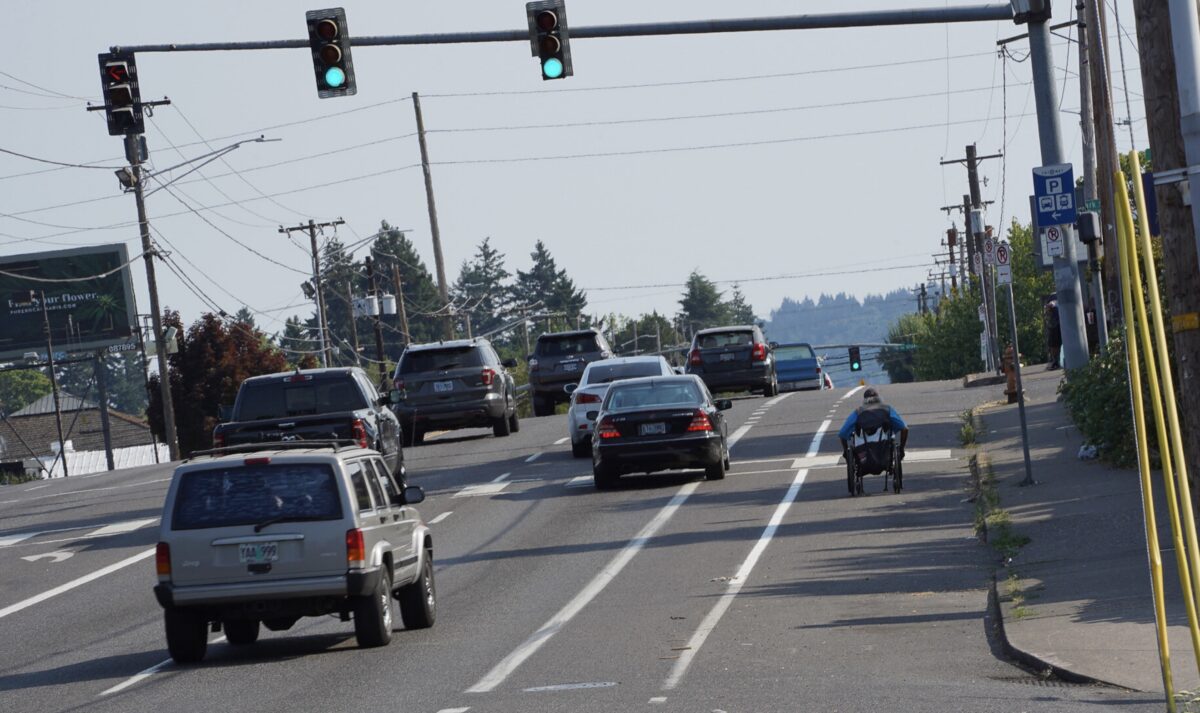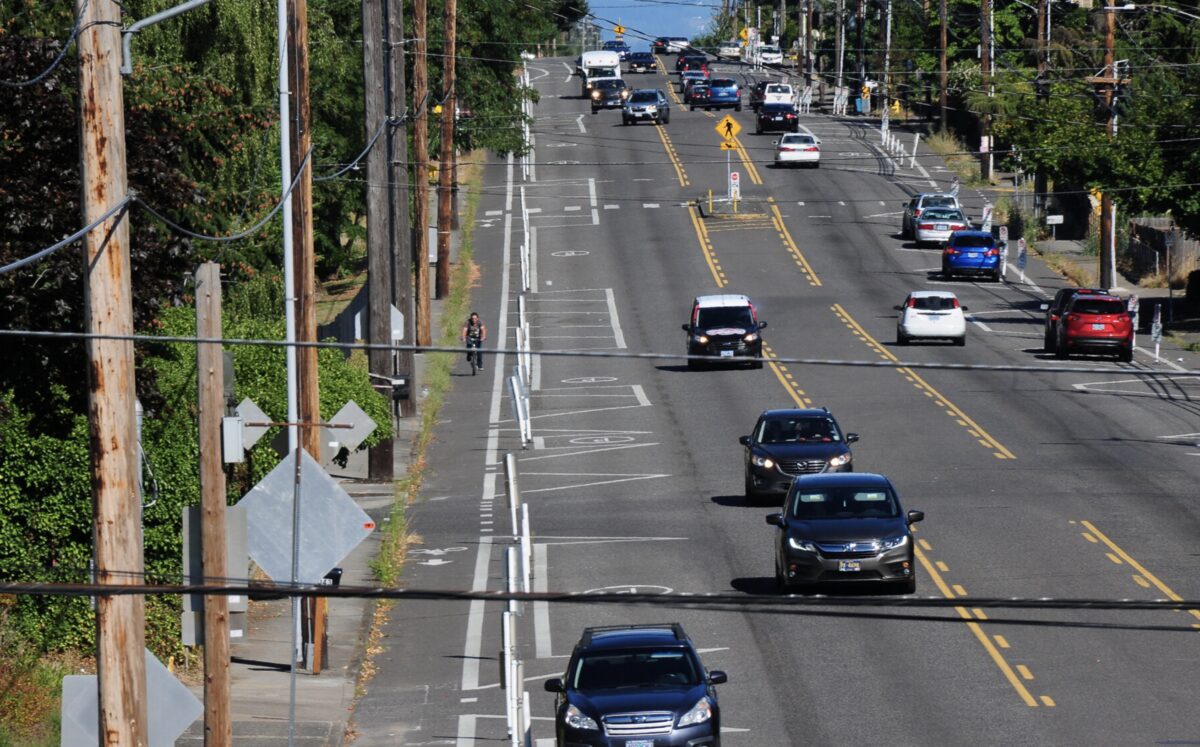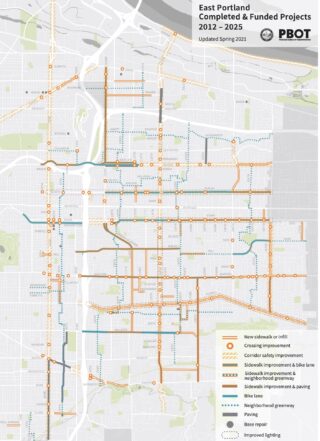



What has changed in east Portland since the Portland Bureau of Transportation implemented the East Portland in Motion (EPIM) active transportation plan 10 years ago? In the decade since, has the city kept its promises to address the area’s lack of infrastructure investment?
“2022 is a big year for these projects. Some did take longer, but now they’re on track.”
— Steve Szigethy, PBOT
PBOT is proud of progress made, but some advocates say more needs to be done.
PBOT’s ‘In Motion’ plans for creating and expanding active transportation systems in different parts of the city now extend across Portland. The ‘In Motion’ framework, of which EPIM was the first, is designed to encourage active transportation like walking, biking and taking public transit in order to create healthier streets and communities and help combat climate change and other goals.
As city, regional and state politics shine a light on infrastructure in east Portland, we wanted to know just how much progress has been made since the release of the EPIM final report in 2012, and how much remains to be done.
In the EPIM report, PBOT acknowledges the lack of investment and how it has impacted the area:
“East Portland… can be hard to navigate on foot or by bicycle or transit. Features that make active transportation attractive in other areas of Portland, like sidewalks, low‐stress bikeways, and frequent transit, are harder to find east of 82nd Avenue. Still, many people who depend on active transportation choose to live in east Portland for its lower housing costs, and often must walk, bike or wait for the bus in substandard conditions.”
As we’ve reported before, east Portland is a part of the city where some people, particularly Black people, were forced to relocate after being displaced from neighborhoods like Piedmont and Boise-Eliot. With East Portland in Motion, PBOT planners hoped to address some of these challenges.
Advertisement

The 2012 EPIM report, and subsequent project planning, was developed after months of community brainstorming that involved east Portlanders sharing what they wanted from a new transportation plan. Some of their highest priorities were safe access to and from transit stops, development of different kinds of sidewalks, low-stress bikeways and a focus on creating conditions so that streets would be safe for children.
The recommended EPIM projects included sidewalk infill, crossing improvements, neighborhood greenways, protected bike lanes, bike parking, trails, roadway improvements and a focus on programs like Safe Routes to School and projects on the city’s High Crash Network.
Last year, PBOT released an EPIM status update to mark the 10-year anniversary. Looking at the last ten years, PBOT employees and east Portland transportation activists have varying thoughts on the success of the plan thus far and which areas are still important focus on.
While there remains a strong public narrative that east Portland doesn’t get the investment or attention it needs, PBOT staff say a lot of progress has been made.
Steve Szigethy, PBOT’s Capital Delivery Division Manager, shared in an interview with BikePortland that one of the most substantial categories of EPIM plans that have been completed are the sidewalk infill projects, which they separate into categories based on whether or not curbs or stormwater exist. Missing sidewalks on major arterial streets like Stark, Division and 122nd Ave have been repaired, and almost all of the more simple sidewalk infill projects that didn’t require PBOT to install curbs and stormwater drainage have been completed.
According to PBOT project data, they’ve designated just over $10 million each to the two types of sidewalk infill projects. All of the simple sidewalk infill projects have found funding and most have been completed or are in the process of completion, but only five out of 14 of the more complicated infill projects are done. Some examples of these incomplete sidewalk infill projects are at NE 111th Dr/Ave from Klickitat to Halsey and the SE Holgate Blvd shared pathway at 130th to 136th.
But Szigethy says PBOT is still paying attention to these more complex sidewalk infill projects, and many of them are well on their way to completion.
EPIM also outlined quite a few crossing improvement projects, categorizing them by different funding pools. The crossing improvement projects associated with sidewalk infill have been largely successful, like at crosswalks along 122nd Ave and SE Stark St at 160th Ave. The Oregon Department of Transportation (ODOT) and Metro have also funded crosswalk improvements along 122nd Ave.
Szigethy also points out the protected bike lanes – which were a fairly nascent concept in the city and country at the outset of the plan – that are now present in east Portland thanks to EPIM.
Advertisement
In combination with other PBOT programs like the Outer Division Safety Project, as well as a refocus on what protected bike lanes actually are, the city has demonstrated an effort to build a more substantial protected bike lane system in east Portland on Halsey/Weidler, Glisan and Division Streets.
Another key area of focus is the east Portland neighborhood greenway system. The ‘130s’ and ‘HOP’ neighborhood greenways debuted in 2020, and the 100s and 150s greenways are both being built or expanded, forming links through the area. Seven out of the 10 EPIM greenway plans are either completed or currently in construction.

As you can see in the chart above, PBOT identified 109 projects in the initial EPIM plan, of which they consider 61 “done” or “partial done” as of June 2021. That’s about 56% of the projects in 10 years. The city has since identified an additional 43 projects east Portland needs for a total of 152 projects they are currently tracking. Of those, they consider about half — 77 projects — done or partial done. The total amount of funding to complete all 152 projects would be around $319 million, when you add needed paving and bridge replacements the figure jumps to $346 million. As of last June PBOT says they’ve either already spent or plan to spend $204.7 million in the past 10 years.
To east Portland transit advocates like Jim Chasse, however, there is still plenty of work to be done. Chasse doesn’t want the spotlight to be taken off east Portland, and thinks it’s important to continue asking PBOT for more transparency on its plans.
Initially, PBOT’s plan was that EPIM projects would be completed in five years. In reality, getting some of these things done has taken a lot longer than that.
“There are lots of projects that haven’t been completed,” Chasse says, specifically pointing to the greenway projects that were delayed. With an increasing population in east Portland, Chasse says there needs to be an urgent focus on getting these active transportation projects completed.
Advertisement
Chasse has worked with Nick Sauvie, the executive director of the ROSE Community Development Corporation in outer southeast Portland, to advocate for more active transportation in the area. Sauvie has done an equity analysis of investments in different parts of the city that showed investment in east Portland hasn’t reached parity with other areas.
“It’s taken constant vigilance and advocacy to get the city to focus on east Portland.”
— Nick Sauvie, Rose CDC
“It’s taken constant vigilance and advocacy to get the city to focus on east Portland,” Sauvie says. “[Improvement] will take a level of investment that the city has come nowhere near reaching at this time.”
PBOT officials say that they can work on multiple things at a time, and just because the wheels may be turning on other ‘In Motion’ projects in other parts of the city doesn’t mean east Portland is being ignored.
Since EPIM was the first project the city worked on through this framework, Szigethy says PBOT has learned valuable lessons about projects moving forward – as well as the dangers of biting off more than it can chew.
“Some of EPIM’s projects were quite large,” Szigethy says. “Other ‘in motion’ projects are now more bite-sized, so they’re easier to get done faster.”
It’s important to keep in mind that PBOT works on east Portland projects outside of EPIM. The major investment on 82nd Avenue being just one example. ODOT has also stepped in to assist with funding in east Portland with plans like the Outer Powell Safety Project and many projects on 82nd Ave.
Beyond projects and funding prioritization, PBOT Planner Bryan Poole told us he thinks EPIM was a great way for like-minded people to voice their needs in a part of town that has been historically overlooked. “The great thing about EPIM is that it helped advocates rally together,” Poole says. “We’re continuing to grow in the data we use and who we reach out to to get an understanding of needs.”
Advocates in east Portland have also seen their priorities represented by a growing power base of political leaders. Oregon State Rep. Khanh Pham who was recently appointed to the legislature’s powerful Joint Transportation Committee, Portland Transportation Commissioner Jo Ann Hardesty and newly-appointed Metro Councilor Duncan Hwang are all east Portland residents who’ve taken their values around equity and transportation justice for their fellow neighbors with them into office.
That political backdrop is well-timed for EPIM’s 10th anniversary. Szigethy says east Portlanders can look forward to seeing more changes come to fruition this year.
“2022 is a big year for these projects,” he says. “Some did take longer, but now they’re on track.”



